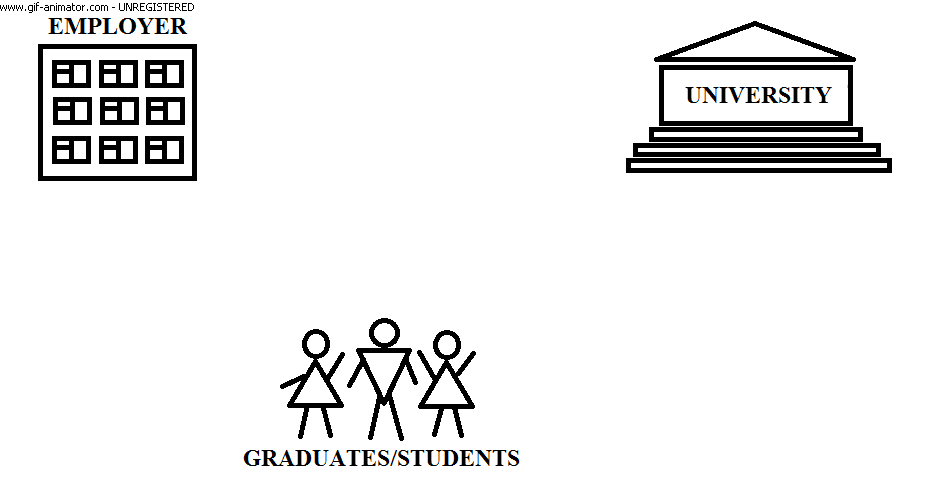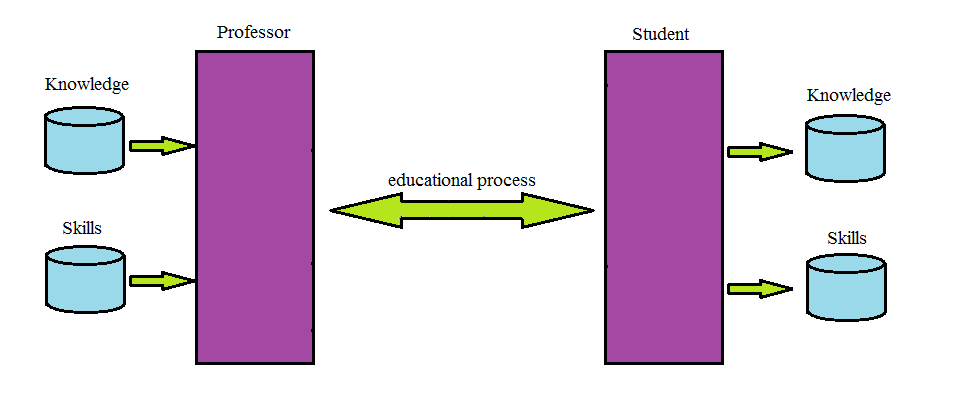Abstract
Contents:
- 1. Aims and objectives
- 2. Relevance of the topic
- 3. Scientific novelty
- 4. Expected practical results
- 5. A review of research and development
- 6. The theory of agent‑oriented systems
- 6.1. Intelligent agent
- 6.2. Multiagent systems
- 7. Agent‑based modeling of training and employment of young specialists
- Conclusions
- References
1. Aims and objectives
The aim of this work is to build a simulation model of the process of preparation of young specialists with the help of agent‑oriented approach.
Objectives:
- The analysis of the process of training of university students as systems with distributed intelligence.
- The description of the knowledge transfer procedure from the teacher to the student.
- Definition of external and internal factors, affecting on the academic performance of students and the quality of absorption of knowledge and skills.
- Development of a definition technique of teachers and students mental and psychophysiological characteristics.
- Design artificial agents patterns for teachers and students on the basis of neural networks.
- Development of artificial agents learning algorithms.
2. Relevance of the topic
Agent‑oriented approach to modeling is a variant of simulation models presentation. They are presented as an aggregate of artificial interactive agents. The fundamental concepts are the concepts of the agent and its mental behavior, depending on the environment in which it is located.
Agent‑oriented models are special class of simulation models, based on many agents individual behavior and created for computer simulations. These computer simulation is closely interrelated with the following concepts: computable economy, complex distributed systems, method Monte – Carlo, computational sociology, systems with many intelligent agents and evolutionary programming.
These models allow to describe processes not only with mathematical rules, but also with other factors, such as psychology, economics, and social factors. This makes the tool very popular in modern science.
The relevance of this study is that built model will allow to analyze the quality of the educational process in a higher education institutions and to predict the employment of graduates. This model will take into account distribution and intelligence training system of students of the University, and the factors affecting them.
3. Scientific novelty
The model will be more realistic to reflect the transformation of knowledge in educational process teacher – student
, that is to simulate the process of professional skills transfer and knowledge depending on personal characteristics of the participants (teachers and students).
In the developed simulation model will be used methods of artificial neural networks, which makes this work almost unique.
4. Expected practical results
- Agent‑based model of young specialists training;
- The technique of teachers and students personality definition;
- The structure of the artificial agents learning algorithm.
5. A review of research and development
This topic is developing intensively in Donetsk national technical university on the department of applied mathematics and Informatics under the leadership of Professor Fedyaev. Under his leadership thefollowing masters have defended final works:
- Stropalov A. Graduation work
Neural network model of software agents in socially‑oriented multi‑agent systems
. - Lukina Y. Graduation work
Agent‑oriented programming model behavior man in the socio‑economic environment
. - Sudikova J.V. Graduation work
Evaluation the effectiveness of the multi‑agent simulation of systems withdistributed intelligence
. - Zaitsev I. Graduation work
Models collective behavior of intelligent agents in a multiagent modeling systems and enterprise management
.
Agent‑oriented modeling and programming is very populat betwen scientists and programmers all over the world, including those in the leading universities of the world.There is a large site, hosting of electronic scientific publications.
As proof of the importance of this subject in the world is the number of responses to the request for multi agent systems modeling
in search engine Google – more than 12 million.
Multi‑agent systems are used in various fields of human activities, such as education, medicine and economy.
6. The theory of agent‑oriented systems
6.1. Intelligent agent
The term agent
comes from the latin verb agere
, which means act
. In computer science and artificial intelligence agent is autonomous entity which observes and acts upon an environment and directs its activity towards achieving goals.
For artificial agent must have certain intellectual ability, and the ability to interact with owner to obtain jobs and transfer results.
Generally accepted definition of intelligent agent is not ready yet. But the most popular one is the following.
Intellectual artificial agent are the agents, that capable of operating autonomously and flexible to achieve its goals, under the flexibility understand:
Intelligent agents in artificial intelligence are closely related to agents in economics, and versions of the intelligent agent paradigm are studied in cognitive science, ethics, the philosophy of practical reason, as well as in many interdisciplinary socio‑cognitive modeling and computer social simulations.
6.2. Multiagent systems
Individual agents can build multi‑agent systems (MAS). Among the specialists used the following formal definition of multi‑agent system, MAC:
WT = (A, E, R, ORG, ACT, COM, EV),
where: A – many agents environment E, located in the certain respects R and interacting with each other, forming some entity ORG that has set individual and compatible actions ACT behavior strategy and actions, including possible communicative action COM and the possibility of evolution EV.
To use the MAC for industrial application non‑profit association FIPA, suggested a number of norms and standards that developers of multi‑agent systems should run to the MAC are compatible with other systems:
- the agent can communicate with any other agent;
- agent provides a range of services that are available for any agent in the system;
- each agent is obliged to limit its availability from other agents;
- each agent shall determine its attitude, contracts, and so with other agents;
- each agent contains the name and the way (ID of agents) [1, 3].
Disadvantages [4]:
- the main drawback MAC – the unpredictability conduct a complete system based on its constituent components;
- application security is not high;
- modular principle.
7. Agent‑based modeling system training and employment specialists in the labor market
This paper deals with simulation system, which initially includes three types of artificial agents that implement the main features of their real objects and their interaction in simulated process. For modeling of processes of preparation and the employment of young specialists, the following agents:
- university;
- employer;
- graduate.
The interaction of these agents defines the essence of the model training of young specialists for the labour market. In this model there are three types of interaction:
- the interaction of employers and graduates.
- the interaction of employers and universities.
- the interaction between graduates and universities.

Picture 1. The system of young specialists training and employment (animation: 7 frames, 10 cycles of recurrence, 81 kilobyte)
To formalize the interaction of these objects were used the following assumptions and simplifications:
- Process training takes place directly between the teacher and the student, under the influence of the external factor – a training plan, as well as internal factors, which are determined personal characteristics of students and teachers.
- In the process of study for each subject, in accordance with its curriculum, has a certain set of professional knowledge skills and abilities necessary for student learning.
- Real level of mastering by the students of knowledge on the subject is determined by examining the assessment given by the teacher.
- For each student is formed personal (individual) set of knowledge and skills, acquired in the process of learning this discipline and to be used when interviewing employer.
- Curriculum discipline is considered as standard information.
Picture 2 shows the model of learning student to the unkown subject. The output of the model is formed vector – a list of knowledge and skills in one discipline, which the student has mastered after graduation. It is worth noting, that some skills are not present in the final version of the vector, because of student mental characteristics.

Picture 2. The learning process of the student on one subject
The model of interaction between agents is given in figure 4. It illustrates the efficiency of knowledge and skills transmission, depending from the personal characteristics of agents.

Picture 3. Interaction of agents Teacher
and Student
Conclusions
So, in this study will be formalized the process of training specialists, which is the part of the large model of specialists training and employment, which is seen as dynamic system with distributed intelligence. This operation can continue in the direction of formalization of relations betwen universities and employers to optimize studying plan, defined in this model.
The plan of this research is provided by the receiving agent‑based model of training, which will carry out the analysis and forecasting of the teaching students process in the educational institution.
To build software agents who need to implement difficult to formalize the role of the participants of educational process, will be used artificial neural networks are extremely popular in our time.
References
- Лукина Ю. Ю., Федяев О. И. Технология создания мультиагентных систем в инструментальной среде MadKit [Electronic resource]. – Mode of access: http://www.masters.donntu.ru.
- Бугайченко Д. Ю., Соловьев И. П. Абстрактная архитектура Интеллектуального агента и методы ее реализации [Electronic resource]. – Mode of access: http://www.sysprog.info/2005/03.pdf.
- Тарасов В. Б. От многоагентных систем к интеллектуальным организациям [Electronic resource]. – Mode of access: http://www.burnlib.com.
- Jacques Ferber, Olivier Gutknecht, Fabien Michel From Agents to Organizations: an Organizational View of Multi‑Agent Systems [Electronic resource]. – Mode of access: http://www.lirmm.fr.
- Зудикова Ю. В. Оценка эффективности многоагентного моделирования систем с распределенным интеллектом [Electronic resource]. – Mode of access: http://masters.donntu.ru.
- Клебанов Б. И., Москалев И. М., Бегунов Н. А., Крицкий А. В. Мультиагентная имитационная модель муниципального образования [Electronic resource]. – Mode of access: http://window.edu.ru.
- Котенко И. В. Многоагентное моделирование для исследования механизмов защиты информации в сети Интернет – ИММОД 2009 с. 38–47 [Electronic resource]. – Mode of access: http://www.spiiras.nw.ru.
- Лямин Р. В. Многоагентная система обучения студентов на кафедральном уровне [Electronic resource]. – Mode of access: http://masters.donntu.ru.
- А. Н. Швецов. Агентно‑ориентированные системы: от формальных моделей к промышленным приложениям [Electronic resource]. – Mode of access: http://window.edu.ru.
- Зайцев И. М., Федяев О. И. Агентно‑ориентированный подход к моделированию интеллектуальных распределённых систем: Сб. – Донецк: ДонНТУ, 2008. – С. 337–338.
- В. Б. Тарасов. Агенты, многоагентные системы, виртуальные сообщества: стратегическое направление в информатике и искусственном интеллекте // Новости искусственного интеллекта: Сб. – 1998. – № 2.
